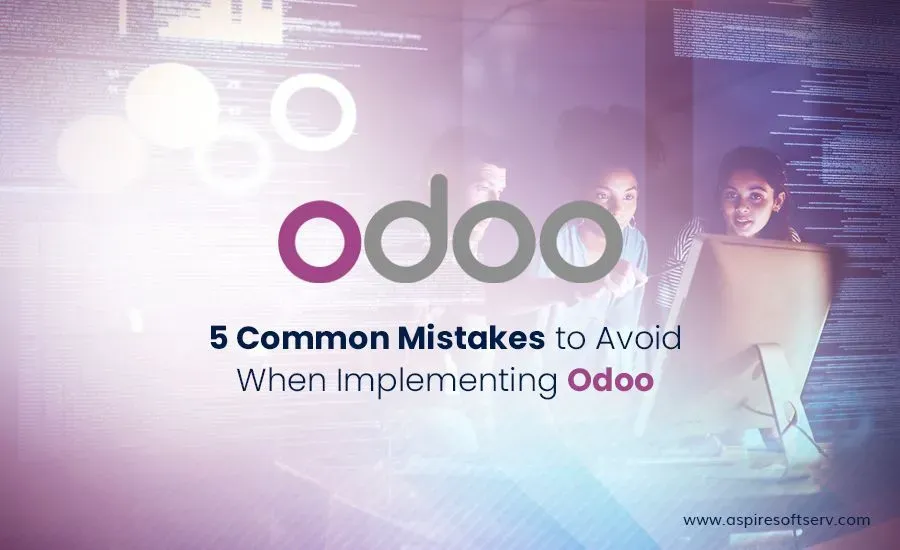
Introduction:
Implementing an enterprise resource planning (ERP) system like Odoo ERP Development can bring numerous benefits to your business, including streamlined operations, enhanced efficiency, and improved decision-making. However, it's essential to approach the implementation process carefully to avoid common pitfalls. This article will highlight five common mistakes to avoid when implementing Odoo, ensuring a successful deployment and maximizing the system's potential for your organization.
Insufficient Planning and Analysis:
Diving into the world of Odoo implementation without a well-thought-out plan is akin to setting sail without a compass. It's a crucial journey that demands more than a perfunctory glance; it requires a deep dive into the intricacies of your business processes. Rushing this pivotal phase is a common misstep that can echo through the entire Odoo integration journey.
So, let's pause and consider this as a pivotal juncture, a moment to methodically chart your course. Take the time to understand the heartbeat of your operations, identifying those pesky pain points that may have become silent disruptors. It's not just about implementing Odoo; it's about sculpting a solution that intimately understands and aligns with your unique business objectives.
As you walk through the maze of your existing workflows, picture not just what is but what could be. This is your canvas, and Odoo, the palette of colors waiting to breathe life into your organizational masterpiece. Outline your expectations with the precision of an artist detailing a vision, ensuring that every stroke of Odoo aligns seamlessly with your overarching business goals.
Think of this planning phase as an investment in the future—a future where operations are not just efficient but gracefully dance to the rhythm of your objectives. By pouring time and attention into this phase, you're not merely avoiding potential hiccups; you're crafting a sturdy foundation for Odoo to waltz into your business ecosystem seamlessly.
So, take a breath, delve deep, and let the planning and analysis phase be the overture to a symphony of success in your Odoo journey. It's not just about adopting a system; it's about orchestrating an evolution tailored to the nuances of your business.
Neglecting Adequate Training and Change Management:
A lack of training and change management can significantly impact the success of your Odoo implementation. Employees must understand how to use the system effectively and adapt to new processes. Allocate sufficient time and resources for training sessions, workshops, and user documentation to ensure a smooth transition. Additionally, implement change management strategies to address resistance to change, encourage user adoption, and manage organizational expectations.
Over-customization:
While Odoo offers customization options, it's crucial to balance customization and the system's core functionality. Over-customizing the ERP system can lead to complexities, increased implementation time, higher costs, and difficulties in future upgrades. Focus on aligning the system with your business requirements without deviating too far from Odoo's standard functionality. Evaluate the necessity of each customization request and consider long-term implications before making extensive modifications.
Inadequate Data Migration and Cleansing:
Data migration is critical to any ERP implementation. Failing to plan and execute data migration properly can result in inaccurate or incomplete data in the new system, causing disruptions to operations and decision-making. Before migrating data to Odoo, ensure that the data is clean, consistent, and properly formatted. Develop a robust data migration strategy, conduct thorough testing, and have contingency plans to address potential issues.
Lack of Ongoing Support and Maintenance:
Implementing Odoo is not a one-time project but an ongoing endeavour. Establishing proper support and maintenance mechanisms can hinder the system's performance and impact user satisfaction. Allocate resources for regular system updates, bug fixes, and security patches. Consider engaging with Odoo partners or consultants who can provide technical support, guidance, and ongoing assistance to ensure your ERP system remains optimized and aligned with your evolving business needs.
Conclusion:
In conclusion, steering clear of common pitfalls during the Odoo implementation journey is paramount for a successful deployment. The strategic roadmap includes meticulous planning, comprehensive training, judicious customization, seamless data migration, and continuous support. These elements collectively pave the way for a smooth transition to Odoo, ensuring that the system aligns seamlessly with your business needs.
While reflecting on these lessons, it's evident that embracing best practices is not just about avoiding mistakes but actively enhancing your business operations. Odoo, when harnessed effectively, becomes a catalyst for transformation, offering the potential to streamline processes and foster sustained growth.
Supercharge Your Business with Custom Odoo Development:
Unlocking the full potential of Odoo ERP is not just a goal; it's an ongoing journey. Our team at AspireSoftserv is dedicated to transforming your Odoo experience into a bespoke solution that aligns perfectly with your business objectives. From tailored modules to strategic consultations, we are here to elevate your Odoo journey.
Get in touch with our team today at [email protected] to discuss your unique requirements. Let AspireSoftserv be your partner in maximizing the power of Odoo, driving efficiency, and fostering growth in every facet of your business. Your journey to a customized Odoo solution begins here.



